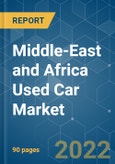The emergence of the COVID-19 pandemic had a huge impact on the automotive sector in the Middle-East and Africa, causing supply chain disruption and transportation halts, as well as a lack of fresh additions to the used car fleet. This resulted in a decrease in the number of models available for purchase, as well as a decrease in the number of purchases. However, in the latter half of 2020, i.e., after Q3 and between Q1 2021, the market began to open up again, returning to pre-pandemic levels and expanding chances for the Middle-East and Africa used automobile industry.
By Q2 2021, Africa accounts for the largest import of used vehicles, around 40%, which is majorly driven by the countries like Nigeria and Libya, 85% of the total vehicle fleet in Africa is contributed by used vehicles. Due to high carbon emissions from the used vehicle and to protect the local vehicle manufacturing industry, several regional regulatory bodies have imposed a ban on the import of used vehicles.
The market for used cars in the Middle-East and Africa is continuously expanding. The introduction of organized participants into the market in developing countries has addressed the trust deficit that has plagued the used car industry in those countries for decades.
Additional factors driving market expansion include rising disposable income levels, rising consumer demand for luxury automobiles, shorter car ownership durations, expanding import-export, and a growing inclination among two-wheeler owners to upgrade to tiny and compact cars. Thus, the consumers in Middle-Eastern countries and the African region have witnessed a steep rise in their purchasing power, and with used car availability, now each and every income class in Middle-East and African region are capable of buying a car, making a prominent share in the market growth. However, the market is still in the growth phase and is projected to witness prominence during the forecast period 2022-2027.
Key Market Trends
Shift towards Unorganized Vendor to Elevate Used Cars Sales In Middle-East and Africa
In late 2016, the Middle-East and African market for used cars was dominated by organized vendors providing all segment cars for the consumer. Consumers in these regions were deeply attracted to these used cars owing to an increase in their purchasing capabilities and a hike in their average disposable income during recent times. Yet, the organized sector of the used car has been completely consolidated owing to only a few retailers and distributors selling the vehicles of all segments on a larger scale.
The majority of the Middle-East and Africa used market is dominated by unorganized players who are operated and function on a very small scale in different provinces. This makes challenges for consumers during the aftermarket services and component supplies.
Hence, after 2016 there has been a steep rise in the shift towards unorganized players from organized players. Small used car selling companies across provinces has made strategic alliances with the key used car suppliers to sell their vehicles on a larger scale. This has made buying and selling much easy for consumers and makes the aftermarket services more reliable and seamless.
The United Arab Emirates to Play a Significant Role in the Market
Among all the regions, the United Arab Emirates has been identified as the growth enabler for Middle-East and Africa used car market owing to the widespread consumer group for used cars in the region. Likewise, Iran, Kuwait, and Turkey are the next countries keeping pace with the market with the United Arab Emirates. The Middle East's second-hand vehicle spare components and the fleet market have grown into a multibillion-dollar sector with more than 100 MSME businesses distributed across the regions.
In UAE, the cars lose their true value after the five-year purchase. Now, based on the condition and fitness of the vehicle, based on electronics tests, tire conditions, and engine health, cars are sent for SDA (Secure Diagnostic Test), which will further decide the sale of the car. This helps the consumer earn trust in the condition and health of the car.
In addition, the UAE is one of the most expensive countries in the Middle East. People are seen generally selling their used cars after 3-4 years owing to changes with the new fleet. This gives an opportunity to all class people to afford a second-hand car in UAE based on economical rates with SDA approved.
Hence, considering all the aforementioned factors, United Arab Emirates is projected to lead at the forefront of the Middle-East and Africa used car market.
Competitive Landscape
The market for Middle-East and African used cars is fragmented. Major players have the edge over other smaller players due to their superior business models and increased number of pre-owned car retail outlets. However, the market is dominated by small and unorganized regional players who are present in most nations.
The growing organized and semi-organized sector is expected to bring in more revenue to the bigger organized players toward the latter half of the forecast period, thus, moving the market ever slightly towards a consolidated one. The United Arab Emirates and Iran, for instance, have an extensive network of used car sellers. These companies are trying to consolidate the unorganized used car segment towards a single umbrella of organized companies offering various services along with used cars as products.
Additional Benefits:
- The market estimate (ME) sheet in Excel format
- 3 months of analyst support
This product will be delivered within 2 business days.
Table of Contents
Companies Mentioned (Partial List)
A selection of companies mentioned in this report includes, but is not limited to:
- Al-Futtaim Group
- Dubizzle Motors LLC
- Kayishha
- Abdul Latif Jameel Motors
- Yallamotor
- Global Cars Trading FZ LLC
- Abi Sayara
- Bavaria Motors








